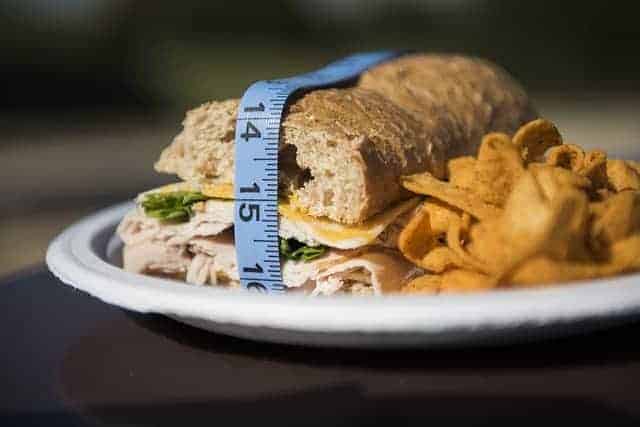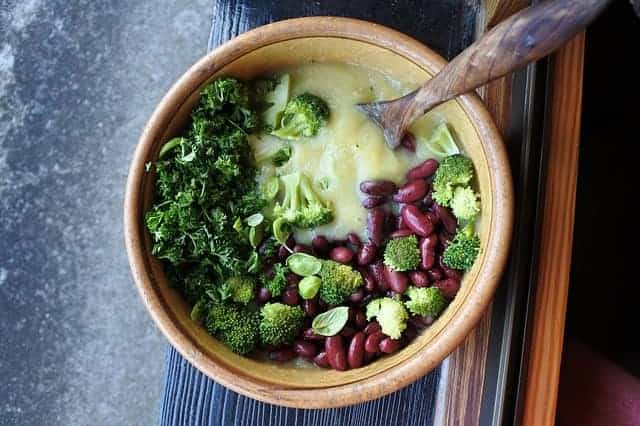The yoyo effect is the last thing a person fighting with excessive kilograms wishes for. The situation, when after a difficult, demanding full commitment and many sacrifices losing weight treatment, we observe that our slim figure becomes bulky and unattractive again, can be a big nuisance and a circumstance that kills motivation for further figure improvement. However, the yo-yo effect is a nightmare that can be avoided, you just need to approach the process of losing excess weight in the right way, and stick to a few simple rules afterwards. Find out what the yo-yo effect is, how it occurs and what you can do to avoid it and not lose your efforts to achieve a slim body.
Table of contents
- 1 The yo-yo effect – what is it and when does it occur?
- 2 The yoyo effect – the causes of the phenomenon
- 3 Weight-loss diets and the yoyo effect
- 4 How to eat to avoid the yo-yo effect?
- 5 What to eat to avoid the yoyo effect?
- 6 Diet without the yo-yo effect – menu
- 7 Physical activity and the yoyo effect
- 8 Additional support – dietary supplements for slimmers
The yo-yo effect – what is it and when does it occur?
Theyo-yo effect is the phenomenon of repeated weight gain following a weight loss cycle. In most cases, the yo-yo effect causes the body weight to increase back to the pre-slimming level, but sometimes it can jump higher, leaving us even more overweight than before the start of the slimming cycle. The yo-yo effect is also called cyclical weight fluctuations, where we lose and gain weight alternately.
The yo-yo effect can occur rapidly or slowly, it can happen right after the weight loss or later, depending mainly on how radical the method of weight loss was and what kind of lifestyle we started following after the weight loss. Usually the yo-yo effect is most noticeable in people who quickly got rid of a lot of excess weight. The more rapidly you lose weight, the more likely you are to experience the yo-yo effect soon.
A key mistake that many people make is to approach weight loss as something temporary, something that lasts a month or two and ends, something after which you can return to your old habits, your old way of eating and your old level of physical activity. Unfortunately, as soon as we enter the path of old habits, we destroy all our efforts to achieve a slim figure, because our body, remembering the established mechanisms, starts to store fat reserves again.
Conclusion? In order to maintain permanent slimming results and avoid the yoyo effect, you need to modify your diet both during and after the reduction. You should also stop living a sedentary lifestyle, which is an ally of slow metabolism and accumulation of fat tissue. What is more, we should learn to choose the right slimming methods, the ones that postpone the risk of weight regain.
The yoyo effect – the causes of the phenomenon

The yo-yo effect can surprise us immediately after the end of dieting, even a few days after leaving the diet, or it can be “postponed in time” and appear a few months after the treatment. There are several main causes of the yo-yo effect, and these are:
- returning to old eating habits after the end of a weight loss diet,
- starving yourself as a way to lose weight,
- not adhering to healthy eating rules after a weight-loss diet, snacking between meals, using processed foods,
- Using inappropriate diets (e.g. monodiet, diets with too low calories),
- abruptly leaving the diet instead of gradually introducing new products,
- not working out after reaching the desired weight,
- sedentary lifestyle.
Weight-loss diets and the yoyo effect
There are many diets that aim to eliminate excess weight, unfortunately most of them do not guarantee permanent slimming effects. Most of them are constructed incompatible with the mode of operation of our body and its demand for nutrients.
The result of a poorly composed diet can be only one – after intensive weight loss, resulting from caloric deficits and increased drawing of energy directly from fat reserves, when we start eating normally, our body greedily absorbs nutrients needed for its proper functioning, and what’s more, having learned from experience, it starts preparing for lean years. So it stores fat reserves with redoubled strength.
So we must be very careful when choosing a slimming diet and avoid all strict menus by a wide margin. So what if we look in the mirror with pride and satisfaction right after finishing a radical diet, if the effect is only temporary.
When, after a month or two, the scale will show the hated number again, all the satisfaction will disappear like a camphor. Putting on weight again after a temporary loss is nothing pleasant. For most people it destroys self-confidence, enthusiasm, sense of self-acceptance and takes away desire for further weight loss. Undoubtedly, we will save ourselves these unpleasant experiences if we slim down with head.
Examples of diets with a high risk of the yoyo effect
- 1000 kcal diet – about a thousand kcal per day is far too little in relation to the real demand of the body (which at an average level of activity is about 2000 kcal per day). By cutting the number of calories consumed daily by half, we lead to large nutrient deficits. Probably being on a 1000 kcal diet we will lose unwanted kilograms, but after the end of the diet our body will start to make up for it and carefully store reserve material in the form of fat tissue.
- Cabbage diet – is one of the most popular diets, which gained its fame thanks to the very fast slimming effects. The basis of the diet is a light cabbage soup, prepared without meat or roux, which is eaten every day in such quantities as we need to satisfy our hunger. Apart from this soup, we have a very limited range of food, including mainly vegetables, fruit and lean meat in small amounts. Very limited calories and lack of sufficient amounts of proteins, minerals and other nutrients cause the body to go into economy mode, which is associated with a slower metabolism. Unfortunately, after finishing this diet, the kilograms often come back.
- Copenhagen Diet – a very strict diet, threatening exhaustion of the body, which leads to severe nutritional deficiencies and lowering of the metabolic rate. After completing this diet, there is a high risk of yo-yo effect. The diet proposed by the Copenhagen Diet is not good for our body. Most days for breakfast we drink only black coffee with a sugar cube, we eat nothing (lack of breakfast is the shortest way to slow metabolism and mental and physical performance degradation), for lunch and dinner we eat hard boiled eggs alternatively with beefsteaks accompanied by vegetables. Sometimes there is a little variety: yoghurt, cottage cheese, a slice of ham, fish, fruit, but even these will not help us avoid significant nutritional deficiencies.
- Vegetable and fruit diet (so called Dr. Dabrowski’s diet) – is a very controversial diet system, in which in the first stage, only vegetables and low sugar fruits are consumed. No dairy, cereals, nuts, meats, fish – there’s no denying that this diet is not complete, generates large nutritional deficiencies (such as insufficient carbohydrates or protein) and disrupts metabolism. What’s more, it brings with it very large energy deficits. Yes, it can greatly facilitate the shedding of excess weight, but unfortunately it also has the other side of the coin. It makes our body get used to ultra-low calorie meals and when, after the treatment, we start eating more, it treats the extra calories as surplus, which should be pushed to the reserves. In this way, all the pounds that we managed to shed come back. Without a doubt, getting off the fruit and vegetable diet without the yo-yo effect is possible, but it is a very difficult task.
- Carrot diet – one of the known monodiet, in which we eat almost exclusively one product, in this case it is carrots. Every day we have to eat about 1,5 kg of carrot and we can serve it in different forms – raw, whole or in pieces, as a salad, stewed, roasted, boiled, as a juice, as a mousse, as a soup… Carrot diet lasts a few days and allows to lose about 3-4 kg, but unfortunately weight loss in this case is associated with loss of water, not fat. There is a high probability that after completing the diet, our body will begin to store water again and the pounds will return. Some people go a step further and extend the carrot diet for further days, losing more weight. In this case you can lose some fat reserves, but the effect is not permanent either. Due to the fact that the carrot diet generates large deficiencies of many nutrients, after its completion the body begins to complement the deficits, which is associated with weight gain.
- Juice diet – consists of eating only fruits and vegetables in liquid form for a short period of time (maximum 3-4 days). It was created mainly in order to radically cleanse the body of toxins, hence its second name – juice detox. The result of this diet is the elimination of excess water from the body and intensive detoxification, which can translate into a rapid disappearance of several kilos from our body. Many people who want to lose a lot of weight in a flash use the juice diet for a week or two (or even longer), which unfortunately turns out to be a mistake. Eating for a week or two almost only with juices is a kind of shock for the body. Even if we manage to significantly reduce our body weight, the yo-yo effect will soon be felt.
- Protein diet (Dukan diet) – a long-term, divided into several stages, slimming diet, whose main principle is to increase the intake of protein products and reduce the intake of carbohydrate products at the same time. Phase 3 and phase 4 of the protein diet are stages of consolidation and stabilization of the new weight and are supposed to protect us from the yoyo effect. Unfortunately, many people who follow this diet admit that despite sticking to the recommendations, the pounds came back (in whole or in part). There is also a large group of people who abandoned the protein diet during its duration and returned to their old eating habits due to bad moods or intensive “asking of the body” for food other than protein.
These are just a few examples of diets that are associated with a high risk of yo-yo effect. In fact, there are many more, in general any diet that is too low in calories (recommends eating less than 1400 kcal per day) or too low in variety (recommends eating only one product or a narrow group of products such as only protein, only juices, only vegetables, only yogurt, only rice, only fruit, etc.) will usually end up in weight gain again.
A diet that eliminates one of the basic nutrients, i.e. carbohydrates (low-carbohydrate diet, or low carb diet) also does not work. A certain amount of carbohydrates in the diet is necessary, otherwise the body starts to malfunction.
How to eat to avoid the yo-yo effect?

If we want to avoid the yo-yo effect, we can use one of the ready-made, not too strict, long-term diets or we can create our own slimming menu. Diets that carry a relatively low risk of the yo-yo effect include:
- the Mediterranean diet,
- vegan diets,
- Hays diet,
- South Beach diet,
- Zone diet,
- the 1500-calorie diet,
- boxed diets.
Remember, however, that after finishing such diets we cannot go back to old, unhealthy eating habits (e.g. eating sweets, ready-made meals, fast food), otherwise we will suffer from the yoyo effect. Instead of using ready-made diet solutions we can also create our own diet, which at the same time will become our new permanent way of eating. We will lose weight slowly but effectively, without the yoyo effect.
Here are tips that will help us lose weight permanently and avoid gaining it again:
- When losing weight, we reduce our daily calorie intake by about 400, maximum 600 kcal. If we cut more than this, the risk of a subsequent yo-yo effect is significantly increased. Once we reach the expected weight, we can increase the calorie intake to a level corresponding to our energy needs (energy needs can be calculated using special formulas available on the Internet), but this must be done gradually, slowly, while maintaining the principles of a healthy diet.
- Both during the slimming diet and after its completion, we avoid all calorie bombs, products made of white flour, alcohol, as well as processed food. We exchange traditional sweets for dietetic desserts, white bread for wholemeal, fatty meals for colourful, full of vegetables, light dishes. We try to permanently eliminate from the menu such products as: fast food, ready-made meals, chips and other salty snacks, coloured drinks, fatty meats and fatty meats, heavy, fatty sauces. We eat fatty varieties of cheese occasionally and in small amounts.
- We avoid starving ourselves. If we skip meals, eat too few of them during the day, take too long breaks between successive meals or eat too few meals (not providing adequate amounts of nutrients needed by the body), we condemn ourselves to lowering the rate of metabolism, and this destroys our intentions to lose weight. Let’s leave hunger strikes and orthodox diets aside. Instead, it is worth introducing a rule of 5 small meals a day (consisting mainly of fibre and protein products), spaced about 3 hours apart. This way we ensure a faster metabolism, we prevent our body from switching to a frugal mode and starting to accumulate reserves and we free ourselves from annoying stomach sucking and attacks of ravenous hunger.
- We permanently eliminate disastrous habits that lead to fat accumulation, such as: snacking between meals and eating stress and negative emotions. It is worth to learn how to fight stress or emotional problems in a different way e.g. by using relaxation techniques. The already mentioned rule of eating 5 light meals with fibre and lean protein will help us to limit snacking. Thanks to such a diet we will prevent fluctuations of sugar level in blood and we will “keep in check” our hunger centre. Snacking is also prevented by numerous slimming tablets equipped with ingredients suppressing appetite. However, when it is necessary to reach for something to eat between meals, let it be a healthy snack, such as a raw vegetable or fruit, a handful of sunflower seeds, a few nuts, healthy chips from kale or other vegetables.
- We fight such weight-creating habits as: eating at night or just before going to bed, fast food resulting in eating too large portions of food, not eating breakfast or eating too poor and too late breakfast. Remember to eat your last meal no later than 2-3 hours before going to bed. Each meal should be eaten slowly until hunger is satisfied (if you eat too fast you will consume more calories because the signal of satiety reaches your brain only about 20 minutes after the start of the meal). Eat a complete breakfast every day, up to one hour after waking up. This will ensure a fast metabolism throughout the day.
The above mentioned tips concerning the way of eating, will definitely bring us closer to our dream slim figure, and at the same time will distance us from the yoyo effect after the treatment. Let’s find out what to eat to prevent the yoyo effect.
What to eat to avoid the yoyo effect?
The optimal rate of weight loss is about 0.5 – 1 kg per week. It may not be spectacularly fast but it protects against a later yoyo effect. Here are the products on which our menu should be based, both during the slimming treatment and after its completion:
- vegetables (e.g. tomatoes, peppers, lettuces, carrots, celery, beets, fresh spinach, sauerkraut and fresh cabbage, radishes, turnips, pickled and fresh cucumbers),
- fruits (mainly low-sugar ones, especially during the first stages of weight loss),
- legumes (e.g. beans, broad beans, lentils, chickpeas, peas, green beans),
- groats (especially the thicker varieties),
- cereal grains, cereal flakes, bran and germ,
- nuts (only natural, without salt and flavoured coatings),
- oil, vegetable oils in limited quantities,
- wholemeal bread,
- rice (especially brown and wild rice),
- wholemeal pasta,
- fish,
- lean meat and lean meats,
- eggs,
- dairy products (e.g. yoghurt, cottage cheese, kefir, buttermilk).

Here is a sample menu with reduced calories, which will help us lose excess weight without the yoyo effect. Note that this diet is well balanced, varied and rich in all nutrients. It does not slow down the metabolism or cause nutritional deficiencies. It ensures weight loss in accordance with the body’s rhythm and carries a low risk of returning the lost kilograms.
Day 1
- Breakfast: 2 slices of wholemeal bread with egg paste, tomato, half a pepper, approx. 100 g cottage cheese with raisins
- 2 breakfast: a few sandwiches (e.g. with kabanos, camembert cheese, olives, peppers and cucumber) plus an apple or pear
- Lunch: light broccoli soup, brown rice, 3 chicken balls in tomato sauce, turnip, carrot and horseradish salad
- Tea time: 5 walnuts, yoghurt
- Dinner: 2 slices of wholemeal bread with cream cheese, lettuce, smoked salmon, light salad of cherry tomatoes, peppers, chives, green cucumber
Day 2
- Breakfast: blueberries on milk with berries, nuts and seeds chia
- 2 breakfast: graham with kale, natural cheese, slices of lean ham and tomato
- Lunch: dietetic goulash soup with peppers, onions, chicken breast meat, tomatoes and red beans, topped with toasted wholemeal bread
- Tea time: strawberries dipped in natural yoghurt with a bit of xylitol or honey
- Dinner: salad with cottage cheese, radishes, cucumber, olives and pepper
Day 3
- Breakfast: a diet omelette (made with 2 eggs, 100 ml of milk and 3 level tablespoons of bran) with a filling of chicken ham, feta cheese, rocket or fresh spinach and tomato slices
- 2 breakfast: 2 carrots, 2 rice waffles, 1 kiwi
- Lunch: 2 potatoes with water, baked or braised cod with herbs, sauerkraut salad
- Tea time: rice with stewed apple and cinnamon
- Dinner: 2 sandwiches with lean chicken sausage, lettuce, tomato, pickled cucumber
Day 4
- Breakfast: wholemeal toast with peanut butter and banana, blender smoothie with buttermilk and strawberries (or other fruit)
- 2 breakfast: diet salad with mix of lettuce, radishes, cucumber, peppers, corn and chicken breast (with yoghurt dressing)
- Dinner: lentil cutlets with garlic sauce, salad bouquet
- Snack: diet dessert with Greek yoghurt, chia seeds, kiwi fruit, honey and nuts
- Dinner: vegetable and chicken ragout
Day 5
- Breakfast: oatmeal with yoghurt and raspberries or peaches
- 2nd breakfast: pumpernickel bread sandwich with chicken tenderloin, pear
- Dinner: tomato soup with wholemeal pasta, grilled turkey fillet, green beans
- Tea time: orange, handful of peanuts
- Dinner: 2 slices of pumpernickel bread with cottage cheese and fish paste, tomato, cucumber
Day 6
- Breakfast: wholemeal roll with lettuce, blue cheese, olives and kabanos
- 2nd breakfast: salad with tuna, peppers, corn, chives, pickled cucumber and brown rice
- Dinner: courgettes stuffed with minced chicken meat with tomato sauce and mozzarella cheese
- Tea time: dessert with millet groats, fruit and nuts
- Dinner: vegetable pate, light salad of kale, peppers and radishes
Day 7
- Breakfast: 2 fried eggs, 2 slices of spelt bread, lettuce, tomato
- 2nd breakfast: salad with avocado, lettuce mix, orange and feta cheese
- Dinner: light stew of turkey and mushrooms, buckwheat groats, red cabbage salad
- Tea time: fruit and vegetable cocktail
- Dinner: cottage cheese with sun-dried tomatoes, pumpkin seeds and basil
Physical activity and the yoyo effect

Physical activity is one of the best recipes to avoid the yo-yo effect. There is a lot of talk about exercise as a way to lose weight, and far too little about its role in maintaining the achieved results. If we see the expected figure on the scale indicators, we reduce the activity that regularly accompanied us during the reduction, and we continue to eat the same (or more), our metabolism will slow down and we will gradually start to gain fat tissue again.
There is no doubt that a permanent introduction of the chosen form of activity to the schedule is an excellent way to stabilize and maintain the new body weight. However, many people, after carrying out arduous training plans and achieving the intended silhouette effects, simply become tired or bored with a given form of activity, and then gradually withdraw from it, again becoming a slave to a sedentary lifestyle.
A way out of this may be switching to another sport or active recreation, or reducing the frequency and intensity of training. The main thing is not to give up regular exercise.
Additional support – dietary supplements for slimmers
Multicomponent dietary supplements prepared for slimming people can be a very valuable support, both in terms of speeding up the fat burning process itself, as well as blocking the yoyo effect. It is worth choosing products which contain ingredients accelerating metabolism, adding energy and suppressing hunger. Thanks to them, we’ll be able to maintain the correct rate of metabolic processes, we’ll be able to control our diet more easily, we’ll avoid snacking and storing fat again, and we’ll maintain our vigour and desire to be active.
Check out our reviews of diet supplements that support weight loss without the yoyo effect:
- Keto Actives
- Piperinox
- Slim Dream Shake
- Probiosin Plus

